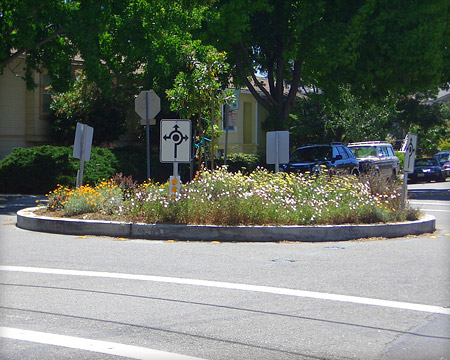A traffic calming circle is a raised island located in the center of an intersection around which traffic must circulate. By providing a landscaped area in the middle of the roadway, they can visually break up the scale of wide streets, break up the monotony of the street grid, and provide space for added greenery and stormwater treatment. Traffic calming circles are generally used at low volume neighborhood intersections.
Traffic calming circles should not be confused with roundabouts, which are designed to handle much higher traffic volumes and reduce vehicle delay.
Process Overview
Traffic calming circles are typically installed as part of a traffic calming project.
For more information on the traffic calming process, see Traffic Calming Overview.
Traffic calming devices including traffic circles require approval by an SFMTA hearing officer.
See Permit Process
Official Codes & Documents
- Better Streets Plan (street design guidelines)
- SFMTA Traffic Calming Guidelines
- DPW Bureau of Engineering Standard Plan for Traffic Circle Details
Design Guidelines
Placement
Street types: Neighborhood Residential
Sidewalk zones: Roadway
Traffic circles should be located on streets where it is desirable to calm traffic and reduce conflicts, such as residential streets.
Design
Traffic circle design should follow DPW Bureau of Engineering’s standard plan for Traffic Circle Details. However, intersection geometry varies greatly, and the standard plan may need to be adjusted for different conditions.
Traffic calming circles should be large enough that vehicles entering the intersection must slow down and change course, but they should not significantly alter the path of travel for pedestrians or bicyclists. The size of traffic calming circles is determined based on the width of the adjoining streets. The installation of traffic calming circles does not usually require a change in curb geometry.
Traffic calming circles should maintain sufficient space such that vehicles do not swing into crosswalks. In properly designed circles, vehicles navigating the intersection will not intrude into the pedestrian crossing area. A minimum of 11’ of clearance between the circle edge and the crossing location should be used per standard plans.
This may mean setting crosswalks back such that they align with the inside edge of the furnishing zone instead of the curb. However, they should retain a linear path of travel from the throughway zone directly to the curb ramp and the crosswalk. Where it is not possible to do this, alternative traffic calming measures should be used.
Traffic calming circles should include signage to indicate the direction of circulation.
Traffic calming circles should be designed with a vertical inner curb and a mountable apron per standard plans. The vertical inner curb prevents vehicles from driving over the circle. The apron is a shallow sloped curb extending out from the bottom of a vertical curb, with a low lip at its pavement-side edge. This apron allows large vehicles to make turns, while slowing other vehicles.
Traffic calming “circles” need not be circular; other shapes may be used to slow traffic in one direction more than others (for example, where a busy street intersects with a residential area).
Traffic calming circles should be landscaped with trees or plantings. Shrubs and grasses should be planted up to 3 feet tall and trees should be appropriately pruned. See Street Trees.
Trees should be planted a minimum of 4 feet from the inside edge of the curb. In traffic calming circles with a diameter of less than 15 feet, one tree should be planted in the center. On a traffic calming circle with a diameter greater than 15 feet, more than 1 tree should be planted and should be equally spaced around the circle.
Traffic calming circles added by neighborhood request should consider added maintenance burdens; this may require maintenance agreements with adjacent property owners.
Where traffic calming circles will be added, they should be reviewed by DPW Hydraulics to ensure that there is sufficient hydraulic capacity within the street cross-section. Stormwater features can help to offset reduced capacity from traffic calming circles.
Existing utility lines may affect the final design and placement of traffic circles.
Maintenance
Maintenance Responsibilities
With some exceptions, fronting property owners are responsible for the on-going maintenance and upkeep of sidewalk paving as well as all sidewalk elements directly fronting their property, such as trees, landscaping, and streetscape furnishings. Generally, the City is responsible to maintain roadway paving and other features in the roadway, such as medians.
See Traffic Calming Overview: Maintenance.
For a more detailed description of maintenance responsibilities, see Maintenance.







 Copyright © 2015
Copyright © 2015